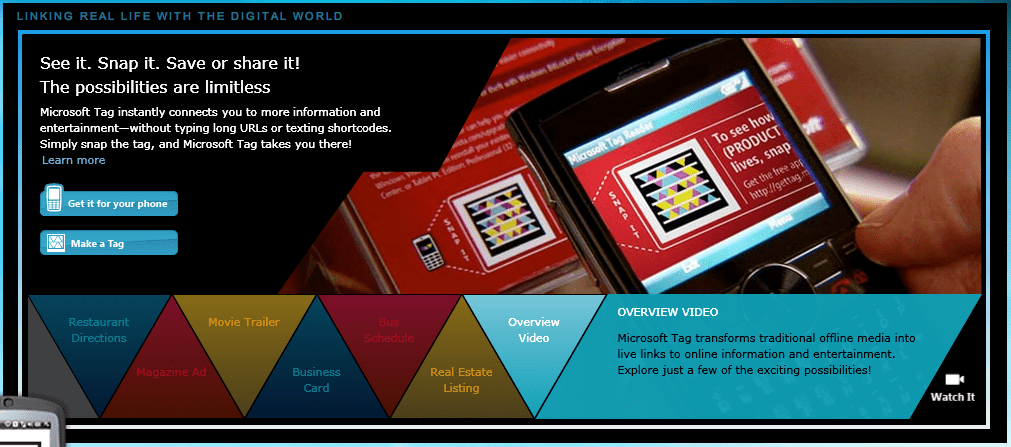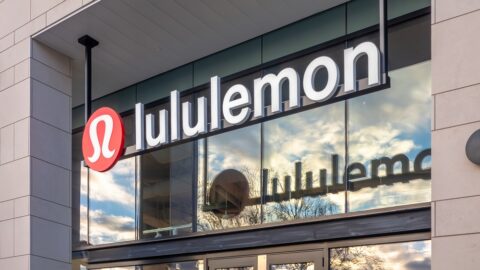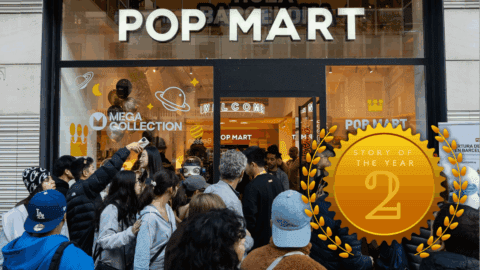Building on the early successes retailers are experiencing with short codes and other mobile marketing, a new technology platform being ushered in by Microsoft could dramatically change the game by bringing the benefits of quick response and the measurement capabilities of online media to the world of offline marketing.
Debuting at NRF next week, the Microsoft Tag is positioned as a “leap” in mobile barcode technology, allowing consumers to quickly tap into marketing offers in print ads, billboards, print packages or store signage without typing in long URLs or texting short codes. By “snapping” a tag with the camera on a web-enabled phone, users are brought directly to an offer page and can either learn more about a product or complete a purchase directly with their mobile phone.
Utilizing High Capacity Color Barcodes (HCCBs) invented by Microsoft Research, the Microsoft Tag platform employs different symbol shapes in geometric patterns and multiple colors to double the amount of information that can be stored on analog printed media, and also improves the readability on lower quality cameras on mobile devices. The HCCBs also provides added flexibility for marketers to integrate into their existing materials, as the tags can be printed as small as 5/8” x 5/8” and no special process is required to print the tag as a color graphic.
The Tag technology is also expected to feed the growing need for ROI as it allows marketers to see when and where customers are responding to ads, across all media with impression activity. It also provides a new way to reach shoppers near or at the moment of truth, as it allows marketers to reach consumers when they are most receptive to products and promotions.
“Currently there’s a limited connection between brands and the mobile lives of consumers, and retailers are looking for ways to engage with the customer in measurable ways during parts of the purchasing process,” says Kevin Kerr, Worldwide Industry Technology Strategist at Microsoft. “Microsoft Tag is an end to end solution that helps stores and brands reach shoppers in a new way and give them access to useful and fun content and product information, using the mobile device so prominent in their lives. It also gives retailers and brands access to analytics that can inform their marketing strategies and promotions, helping them engage with consumers in an interactive way.”
Although still in beta, Microsoft Tag technology is expected to generate a lot of buzz at the NRF Expo next week and many of the industry’s leading players expect the platform could quickly become a widespread solution to enabling cross-channel commerce. “With Microsoft Tag, shoppers can now scan a code and purchase an item from their mobile phones more quickly and easily than ever before. It’s as easy as—snap, order, pick-up,” says David Bruno, Director of Product Marketing for Escalate Retail, which will be featuring a live retail demo of Microsoft’s Tag technology in Booth 2002 at NRF. “I believe that this will make the mobile channel much more prevalent in consumer shopping patterns and also provides the potential to make traditional marketing much more relevant by increasing the ROI and the immediacy of results from these campaigns.”
There is no charge for consumers to install or use the Tag reader, outside of normal data plan charges. In addition, during the beta period, there is no charge for marketers to create and use Tags. Microsoft has also stated that if it does decide to add a charge in the future, any Tags which were created during the beta period will continue to work for a period of two years free of charge.
Steve Ballmer, Microsoft’s CEO touched on the on the growing potential for the Tag application as part of his keynote speech during the Consumer Electronics Show this week, pointing to the massive growth of smartphones. “Over a billion mobile phones are sold each year. And certainly in emerging markets it’s often the first computing experience for many people. Mobile phones are becoming more capable than ever, and over the next several years smart phones will make up over 50 percent of the mobile phone market,” Ballmer said.
According to leading market researcher NPD Group, consumer sales of smartphones in the U.S. increased 85% from January through July 2008 versus the same time period last year. As a percentage of overall handset sales to consumers in the U.S. during that same period, smartphones represented 19% of all handset purchases compared to just 9 percent for the same period the year prior.













